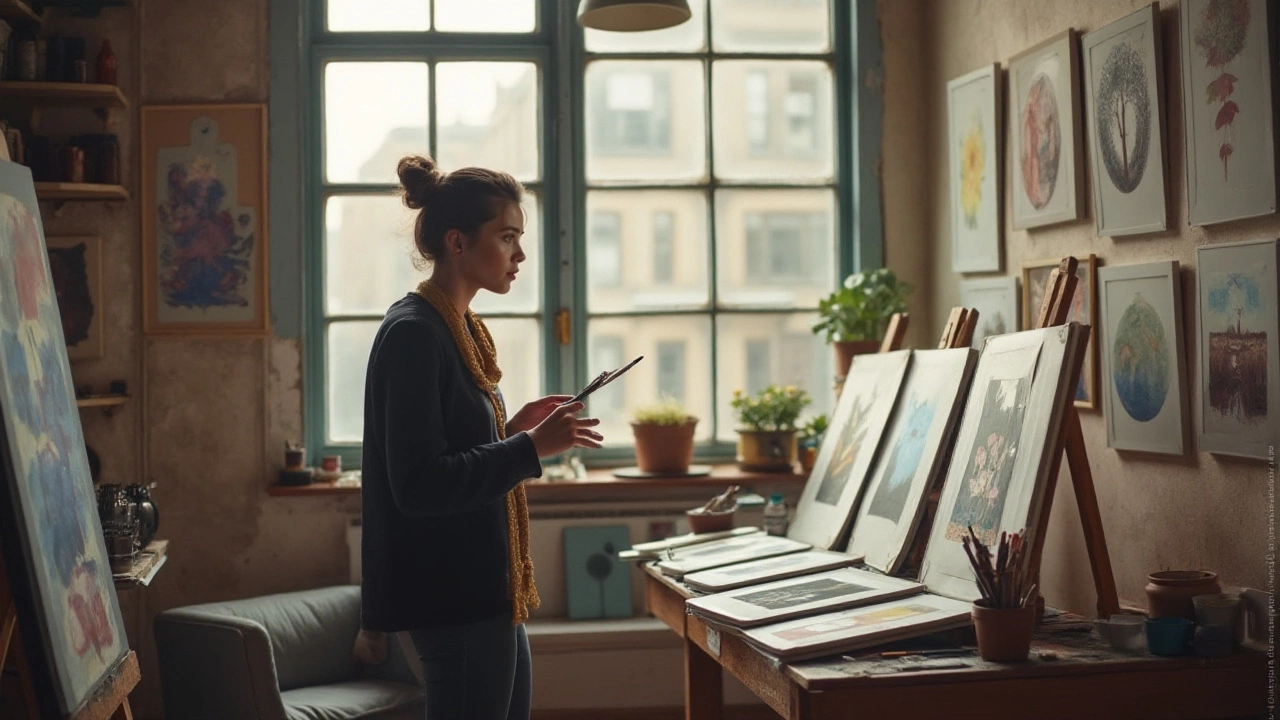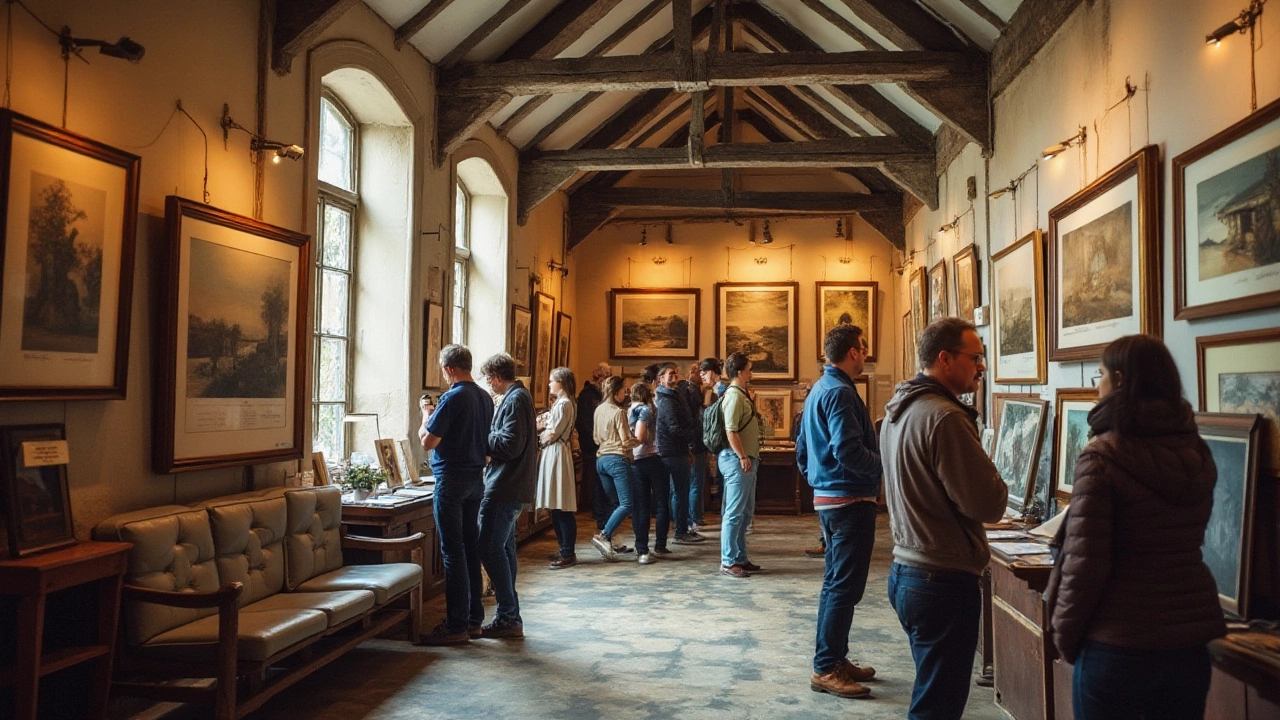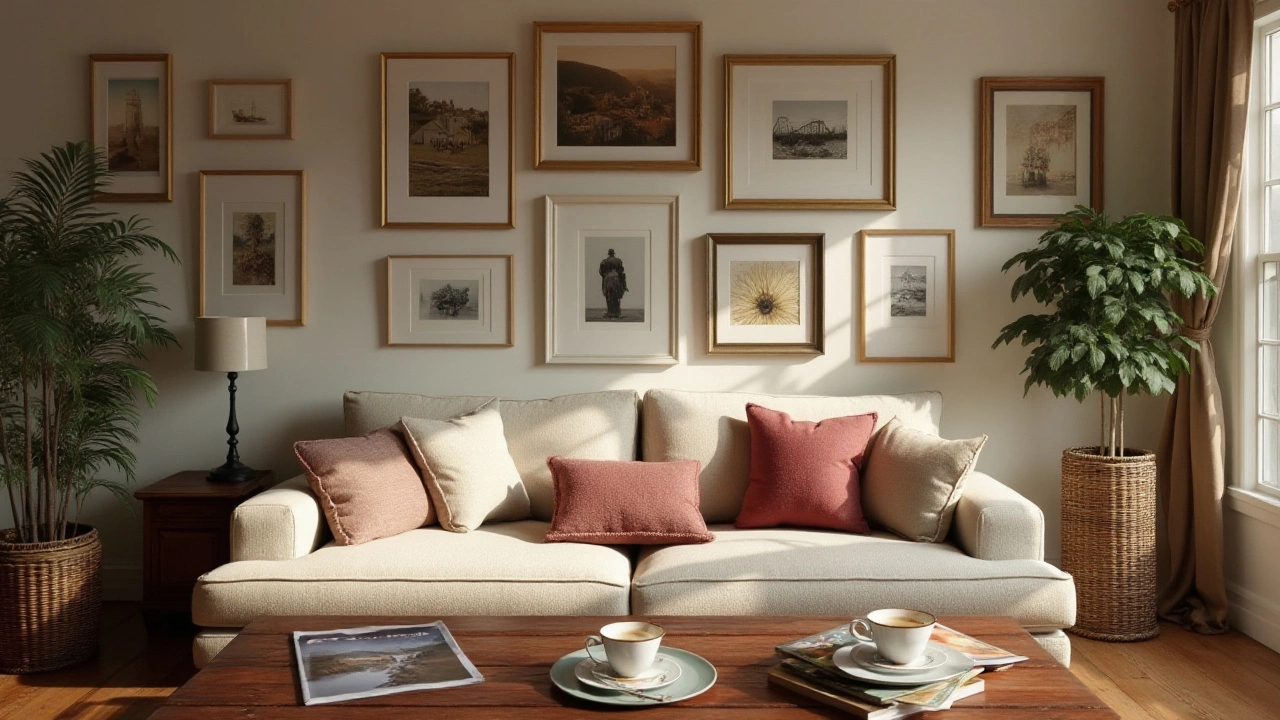In the enchanting universe of art prints, size truly does matter. This isn't just about the physical dimensions, but how a piece speaks to you, fits within a space, and complements the aesthetic of a room. With the growing interest in personalizing living spaces, selecting the right print size has become an intriguing journey for both artists and art lovers alike.
As we explore which sizes attract the most attention, it's important to consider the harmony between art and its environment. People aren't just buying art for art's sake—they're looking for pieces that resonate, inspire, and transform spaces. This article delves into the world of art print sizes, uncovering which ones consistently fly off the shelves, and why.
- The Appeal of Small Prints
- Medium Prints: A Versatile Choice
- Large Prints: Making a Statement
- Considering Space and Placement
- Trends Influencing Print Size Popularity
The Appeal of Small Prints
Small art prints have carved a niche that appeals to a wide spectrum of art enthusiasts and casual decorators alike. Despite their modest size, these prints command a powerful presence, offering flexibility and charm that bigger pieces often cannot. Small prints are incredibly versatile, allowing for easy placement in areas where space is limited, such as in cozy reading nooks, small apartments, or as part of a captivating gallery wall display. One of the primary draws of small art prints is their affordability, which broadens their appeal to younger audiences or those new to collecting art who wish to elevate their space without making a significant financial commitment. These prints enable art collectors to indulge in multiple purchases, creating an opportunity to change displays seasonally or according to mood—adding a dynamic element to home decor.
Beneath their accessible surface, small prints hold the power to create an intimate connection with the viewer. They invite you to step closer, to engage deeply with the details that might be lost on a larger canvas. This closeness fosters a personal experience, often making small prints especially suitable for pieces that evoke emotion or provoke thought. In addition, small prints can serve an educational purpose, providing art newcomers with the chance to explore a variety of styles or artists without significant investment. Museums and art galleries have recognized this, often stocking their gift shops with small, collectible art prints that reflect their exhibitions. These pieces become windows into the world of fine art, offering a taste of grand masterpieces in a more approachable, relatable form.
For artists, crafting small prints offers the potential for wider reach and recognition. An emerging artist can share their work with a broader audience, gaining valuable exposure that could later lead to interest in larger works or original commissions. A quote from Clare Hooper, a notable art critic, encapsulates this sentiment beautifully:
"The beauty of small art prints lies in their ability to democratize art; they turn what may seem a distant dream into a reachable reality for both creators and admirers."When curated thoughtfully, small art prints can transform into impactful gifts, carrying personal stories or shared memories. Gifting someone a cherished print offers more than a decorative item—it's a piece of finely crafted sentiment, a gesture of thoughtful appreciation. This emotion-driven aspect further fuels the popularity of small prints.
As homes continue to evolve into personal sanctuaries, the demand for small prints maintains its strength. Whether displayed solo or carefully curated in a themed collection, they add a warmth and substance that complements the larger pieces in an interior space. The narrative woven by a collection of small prints can be profound, often offering an eclectic mix of different genres or subjects that reflect the owner's personal taste and journey. It's a balance of artistry and accessibility—crafted from fine materials yet lightweight enough to shift with the ebb and flow of one’s evolving taste. Their distinct charm lies in the way they infuse life into smaller spaces, allowing a playful experiment with color, style, and mood.
Medium Prints: A Versatile Choice
Medium prints hold a unique charm in the world of art prints, often bridging the gap between the subtlety of small pieces and the bold statement of large prints. These prints typically range from 16x20 inches to 20x24 inches, making them an exceptional middle ground that suits a variety of spaces. Their versatile nature allows them to harmonize with other decor elements without overwhelming a room, which is one reason they are so popular among both buyers and interior designers.
One significant advantage of medium-sized prints is their adaptability. They can effortlessly find a place in various settings, from cozy apartments to bustling cafes. Whether placed on a narrow wall in a hallway or as part of a curated gallery wall in a living space, medium prints provide aesthetic flexibility. This makes them an ideal choice for individuals looking to refresh their environments with art that complements rather than dominates their existing decor. As the home decor world leans towards eclectic and personalized styles, the demand for medium prints continues to rise.
From an economic standpoint, medium prints offer a great balance of cost and impact. Artists often prefer producing this size because it can be priced accessibly while still delivering a striking visual appeal. For consumers, purchasing a medium print is an investment that brings vibrant artwork into their lives without necessitating a hefty expense. According to a study by the Art Market Research Organization, medium prints account for nearly 40% of all art print sales globally.
"Medium-sized prints offer the perfect balance of art presence without overwhelming a space," notes interior designer Jane Harper, who often recommends them for those looking to infuse personality into their homes.
In addition to their economic and aesthetic benefits, medium prints also offer practical advantages. They are easier to frame and hang than larger prints, which might require special tools or professional assistance. Buyers can experiment with different frames or mount the prints directly on their walls with stylish clips, offering endless possibilities for creativity. For those new to art collecting, medium prints serve as an excellent starting point, allowing them to explore their tastes without feeling committed to more substantial pieces.
Medium prints also enjoy a degree of universality that is less common in smaller or very large prints. While some art is created specifically for larger canvases to achieve a specific impact, many artworks translate beautifully into a medium size. This allows for a wide variety of artists and styles to be represented, from contemporary abstracts and vibrant pop art to serene landscapes and classic photography. The middle ground size of these prints can also be an asset in temporary spaces or for those who like to change their decor frequently. With the ability to fit seamlessly into different themes and spaces, they can travel with you, adapting to new rooms and settings.

Large Prints: Making a Statement
There is an undeniable allure to large prints when it comes to home decor. These magnificent art pieces often serve as the focal point in a room, capturing attention and sparking conversation. Large prints are more than just decorative; they have the power to transform a space entirely by adding a sense of scale and grandeur. When you walk into a room with a bold, large canvas, it is both captivating and immersive. This statement-making quality is what sets large prints apart in the world of art prints.
Such appeal isn't arbitrary; it is rooted in psychological and aesthetic principles. Larger art pieces have a profound effect on viewers, often evoking stronger emotional responses than their smaller counterparts. A large landscape or abstract piece can convey movement and energy, inadvertently setting the tone for the ambiance of the whole room. There's so much to consider about where these prints are placed, as they demand space and visibility in ways that smaller art doesn't. In spaces like living rooms or offices, where you might desire an impressive centerpiece, large prints are an ideal choice.
"Art should comfort the disturbed and disturb the comfortable." – Cesar A. Cruz
Among popular art print sizes, larger options transcended mere aesthetics during the pandemic when people sought inspiration and solace indoors. These works of art turn blank walls into canvases of emotion and thought. Often, artists and purchasers alike are drawn to larger sizes for their expressive potential, as they can fill a space both physically and emotionally. The spaciousness of a large print invites viewers to lose themselves in the details, much like how a mural might offer perspectives from different angles.
Choosing the Perfect Spot for Large Prints
Placing large prints requires thought and care. The right spot can amplify the statement you wish to make. Consider the natural lighting, as it can affect the visibility and mood of the artwork. Spacious walls free of obstructions are prime real estate for such pieces since large art is best appreciated from a distance. In contrast, smaller spaces might feel overwhelmed by them. Optimal placement could be above a sofa in the living room or as the centerpiece on a blank wall in a dining area. These strategic placements allow the print to become a part of the architectural story of the room, encouraging onlookers to pause and admire it.
When it comes to sales, larger sizes have distinct market trends. Their popularity doesn't just stem from aesthetics but also the appreciation of art as an investment in one's environment. Around 2022, reports indicated that art lovers were increasingly leaning towards larger format prints, perhaps as a reaction to the minimalistic and digital age. A table of sizes popular among art buyers might reveal the growing trend:
| Size | Popularity Growth (%) |
|---|---|
| 30x40 inches | 45% |
| 36x48 inches | 30% |
| 40x60 inches | 25% |
This trend reaffirms a distinct shift in buyer behavior with people choosing art that not only complements but indeed defines the spaces they live and work in. Whether it's a 30x40 inch piece or a dramatic 40x60, each serves a unique purpose, turning walls into windows to another world.
Considering Space and Placement
Choosing the right art prints for a space involves more than just picking a size. It's about considering how a piece will interact with the room it inhabits. Every wall tells its own story and the art we hang on them plays a big part in that narrative. Even the most magnificent artwork can fall flat if it's not thoughtfully placed within a space that complements its size and energy. A common approach is to evaluate the wall dimensions before anything else. Experts often suggest that an art piece should occupy about 60-75% of the wall space for it to feel proportionate and harmonious.
When you're aligning your selling sizes with a room's design, the room's purpose matters just as much as its architecture. Living rooms, for example, are typically the heart of a home and can greatly benefit from a bold statement piece. Bedrooms, on the other hand, might call for more calming and intimate prints that offer serenity. Dining rooms, often centers of hospitality, can become places of inspiration with vibrant or conversation-starter art prints. Each of these spaces has its own requirements and charisma, leading to a need for thoughtful selection of art sizes that best suit the setting.
Understanding how space is lived in day-to-day should also be a consideration. Hallways with narrow walls aren't suitable for wide or landscape formats, but they can be refreshed with a series of small and medium portraits that invite visitors down the length of the corridor. Tall art prints come in handy for rooms with high ceilings, drawing the eye upward and adding a sense of grandeur. Alternatively, collections of smaller prints on a large wall can make an intriguing gallery effect. As the celebrated interior designer Nate Berkus once said,
"Your home should tell the story of who you are, and be a collection of what you love."This expression suggests harmony between art and its placement is essential for achieving a captivating living space.
Additionally, the technological age influences how art buyers visualize art in their spaces before making decisions. Several apps and platforms now allow users to superimpose images of popular art prints onto photos of their own living rooms, providing a mock-up that helps in deciding both style and the ideal size. This tool can be pivotal in understanding the scale, which remains one of the trickiest aspects of buying art online, bridging the gap between reality and guesswork.
Lastly, it's beneficial to pay attention to the light sources in a room. Natural light can transform the colors of art prints throughout the day; thus, ensuring prints aren't overwhelmed by direct sunlight (which can also damage them) is crucial. Conversely, artificial light, too, can either dull or enhance an artwork's vibrancy depending on positioning. By being mindful of space dynamics and the interplay of natural and artificial light, artwork can truly shine. Effective utilization of these elements isn't merely about displaying a piece but celebrating and enhancing its beauty.

Trends Influencing Print Size Popularity
The popularity of certain art print sizes can be attributed to several influencing factors, many of which are closely tied to evolving home decor trends and changing lifestyles. In recent years, there has been a noticeable shift towards minimalism and a preference for open spaces, which naturally influences the size of art prints people choose for their homes. Larger prints that make a bold statement have seen a rise in popularity, especially in spaces designed with minimalist themes. These sizable artworks often serve as a focal point, drawing attention and setting the tone for a room.
Additionally, the rise of urban living has seen many individuals moving into apartments and smaller living spaces. This trend has sparked interest in medium prints that offer a balance between impactful design and space conservation. Medium prints, typically around 16" x 20" to 24" x 36", are versatile and can be displayed solo or as part of a gallery wall. This flexibility makes them appealing to younger generations who often change their decor as frequently as they do music playlists.
Social media has also played a significant role in shaping the popularity of certain art print sizes. Platforms like Instagram and Pinterest are brimming with images of eclectic walls and boho-chic decor styles that incorporate a mix of small prints and varying sizes. This visual melting pot thrives on creativity and personal expression, encouraging users to experiment with different arrangements. Artists and sellers who tap into these trends can see a notable impact on their sales.
An interesting fact to consider is that art enthusiasts often turn to online marketplaces and social media for their art prints. According to a recent survey, 67% of art buyers below the age of 35 said they discovered and purchased art through online platforms. This digital trend means the art is selected based on how it will look in photos shared on these platforms, sometimes slightly skewing the demand towards sizes that photograph well and maintain proportion within a digital frame.
There's also a noticeable preference for personalization in art collections. Consumers are increasingly looking for artwork that tells their story or aligns with their personal experiences. This often leads to a demand for custom sizes, especially when considering unique spaces in a home like a reading nook or a hallway. Offering a variety of sizes with customization options can significantly boost the appeal of art to these discerning buyers.
A leading interior designer recently remarked, "In the world of decor, art is not just an accessory; it has become the centerpiece around which a room's design revolves. The right size can beautifully anchor a space, giving it both depth and character."
With the ebb and flow of trends, it becomes apparent that while certain sizes can enjoy popularity spikes, the key lies in the ability to adapt and offer what suits evolving tastes and spaces. Artists and sellers who keep a keen eye on these changing dynamics can position themselves well within the art market, providing creations that not only connect with buyers emotionally but also fit their practical and aesthetic needs.

